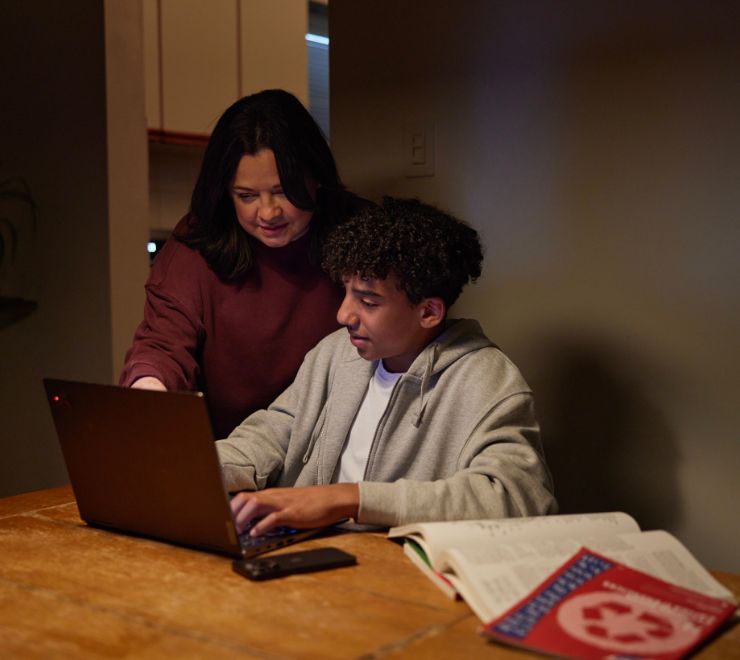Bullying and harassment don’t just take place on the playground. Things such as rumours, gossip, threats and insults can happen online and are considered cyberbullying. In this story, Kids Help Phone shares information about cyberbullying and actions you can take to try and address the behaviour.
You can tap on the video below to view an interpretation of this story in American Sign Language (ASL).
What is cyberbullying?
Cyberbullying is a type of bullying and involves the use of technology to intimidate, hurt or humiliate someone. Cyberbullying can follow a person around 24/7 through social media, texts, emails, websites and other digital channels. Cyberbullying can include:
- sending cruel or threatening emails / messages
- posting embarrassing photos, videos, comments, etc. of someone
- creating a website to make fun of someone
- posting insults on someone’s social media page(s)
- making up fake accounts on social media to ridicule others
- spreading secrets / rumours about people online
- harassing other players in online video games
- recording someone secretly and sharing it on social media
You can learn about the impacts of cyberbullying by visiting PREVNet.ca.
What’s different about cyberbullying?
Cyberbullying can differ from in-person bullying because it:
- can occur at any time and spread quickly
- is often shared to a larger audience
- is often easier for people who cyberbully to hide behind technology
- can contain content (e.g. photos, videos, etc.) that’s humiliating
- can be harder to stop
- is difficult to permanently remove content after it’s shared online
I’m experiencing cyberbullying — what can I do?
If you’re experiencing cyberbullying, it can hurt and leave you feeling isolated, humiliated, confused, scared, etc. Try to keep in mind that even if it takes time for the situation to get better, there are things you can do to help address the behaviour.
Consider how you react
If you experience cyberbullying, your instinct might be to react immediately. It can help to take a breath and avoid responding right away. You can take a screenshot as a record of the harassment (if possible). If you receive a harassing message on your phone / social media, you can block the person who sent it, too.
Get support from a resource you trust
You can try connecting with a person / service you trust to help you identify other things you can do. Here are some tips for getting support:
- Reflect on your needs: Having an idea of what might be most helpful for you right now can help you choose a way forward. Do you need emotional support? Someone to help you figure out what to do next? Someone to help you contact a school, emergency / community service, etc.?
- Choose a support: When you identify what might be most helpful for you, you may have a better idea of the people / services you can connect with. Try to keep in mind it may take a few tries before you find a resource who can help in a way that’s best for you.
- Connect with a support: Try to be honest with the person / service you choose to communicate with. If you just need someone to know about what happened, it’s OK to share that with them. If you’re ready to report the harassment, and you’re seeking help in doing so, try to be clear and tell the person / service this is what you need. You may be able to come up with a safety plan together.
- Contact emergency / community services: If you’re being physically threatened / feel your safety is in danger, you can contact the emergency / community services nearest your area right away.
Practise online safety (as best you can)
The following tips can help you put your safety first online:
- keep your passwords private, even from your friends
- learn about privacy settings and reporting features on social media
- be mindful of what you post and share online
- block people who are making you feel unsafe
Blocking someone can vary depending on device, channel and settings. To learn more, you can search for your specific device / channel online along with the question, “How do I block someone on ‘X’?”
I’m a bystander to cyberbullying — how can I take action?
Any time a person reads an abusive comment about someone, views an embarrassing photo / video of someone, follows a link to a website designed to humiliate someone, etc., they’re a bystander to cyberbullying.
Just like in-person bullying, when you notice someone experiencing cyberbullying, you can play a role in helping to stop the abuse. You can learn more about navigating cyberbullying by exploring MediaSmarts.ca.
Tips to report cyberbullying
People who are cyberbullying are often motivated by the belief that others will approve of their behaviour or think it’s funny. Sharing your feelings about what’s happening and telling the person their behaviour is not OK (if it’s safe to do so) might motivate them to stop.
If you feel it’s safe to do so, you can address the behaviour by messaging the person who’s cyberbullying directly / privately. You can let them know why you’re upset by their behaviour, how it might be hurting people and ask them to stop.
If the content is on social media, you can report it as inappropriate and ask for it to be taken down. For more information on removing photos / videos on the internet, you can visit NeedHelpNow.ca.
Note: Some other pages on NeedHelpNow.ca use language that we would not use at Kids Help Phone (i.e. referring to sexting as self / peer exploitation). However, this particular page has useful information on how to report online violence.
How can I help someone who’s experiencing cyberbullying?
It can be hard to know how to help someone who’s experiencing cyberbullying. As someone who cares, you can help by being a friend. You can connect with the person and ask how they’re doing, remind them you’re there for them and let them know the situation isn’t their fault. You can also discuss ways to get support together.
Cyberbullying can be a challenging issue to navigate, and you don’t have to do it on your own. For free, private, 24/7 support with anything on your mind, you can contact Kids Help Phone.



















